New Jersey Republicans Nearly Entirely Shut Out Of Congressional Delegation
Election Day 2018 saw Republican representation in the New Jersey Congressional Delegation nearly entirely decimated.
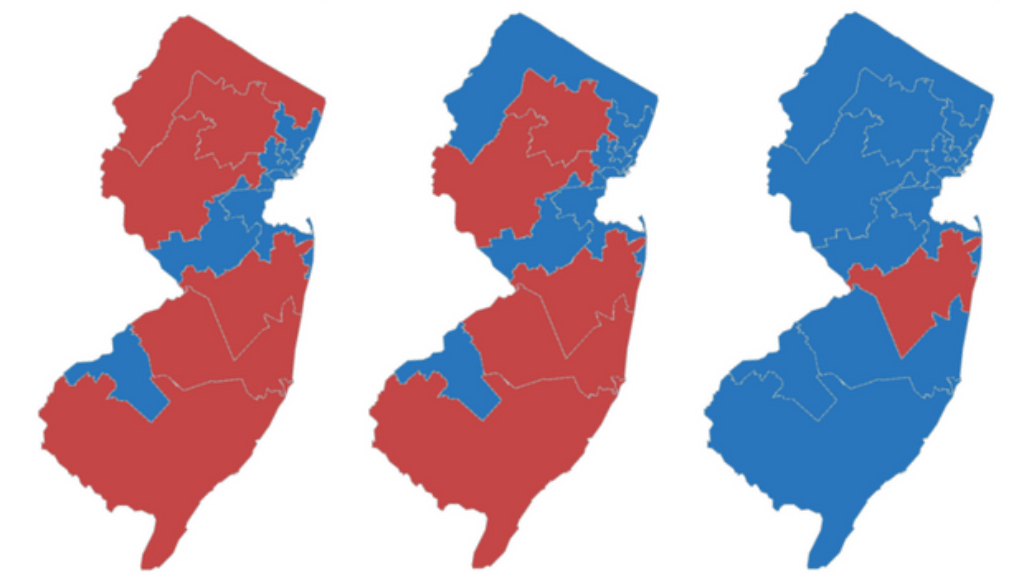
One example of the extent of the Democratic victory last week can be seen in New Jersey, where the Republican presence in the state’s Congressional delegation has been nearly entirely eliminated, The New York Times has the details:
Andy Kim, a New Jersey Democrat who had been locked in a neck-and-neck race for Congress, has defeated his Republican opponent, a two-term incumbent and staunch ally of President Trump, according to a final vote tally.
After a drawn-out vote count, Mr. Kim, a former national security adviser under President Barack Obama, was declared the winner by a slim margin, beating Representative Tom MacArthur, who wrote a key amendment in the effort to repeal the Affordable Care Act, according to The Associated Press.
The victory by Mr. Kim caps a devastating midterm election for Republicans in New Jersey.
With 11 Democrats now holding House seats, Representative Chris Smith is the lone Republican in Washington from New Jersey; the last time Democrats had such a large advantage Theodore Roosevelt was in the Oval Office.
Mr. Kim’s victory in the Third Congressional district comes after a week spent counting more than 7,000 paper ballots in Ocean and Burlington counties. Though the race was too close to call on Election Day, it became increasingly likely in the days that followed that Mr. Kim would prevail.
“I kept hearing a similar refrain: that they wanted to have a new generation of leaders in Washington,” Mr. Kim said in an interview. “I hope to be part of that generation of leaders that can work in that type of way, showing that we can home in on issues across the board.”
Mr. Kim said that he hoped to be given a spot on the House Armed Services Committee, citing his national security background and noting that his district is home to a large military facility, Joint Base McGuire-Dix-Lakehurst.
He also pledged to work to roll back the limit placed on state and local tax deductions under the new federal tax plan and to work with Gov. Philip D. Murphy, a Democrat, and the rest of the state’s congressional delegation to win funding for the Gateway rail tunnel project under the Hudson River.
The map above is a representation of what the Congressional map in the Garden State looked like after the elections in 2014, 2016, and 2018. While New Jersey is a solidly blue state, it may surprise people to know that, as recently as four years ago, the majority of its Congressional Districts were represented by Republicans. By and large, these Republicans were representing districts in the suburban and rural part of the state where the population is predominantly middle to upper-middle class, and many of them, such as retiring Congressmen Rodney Frelinghuysen and Frank LoBiando and Congressman Leonard Lance, had been in office for many years, As you can see, though, the makeup of the delegation became bluer in 2016 (the middle map in the graphic above). The final map is the map on the right which shows just a single Congressional District still in Republican hands. That district is the 4th Congressional Districts, which has been held by Congressman Chris Smith since he was first elected in 1980.
To be fair, many of the districts in New Jersey were in danger when long-serving Congressmen such as Frelinghuysen, who is the latest representative of a family with deep roots in New Jersey and American history that include a high-ranking officer in the Continental Army during the American Revolution, a Senator, Members of Congress, and a Secretary of State, and LoBiando decided to retire. However, there can be no doubt that the disdain for Donald Trump played a role in what happened on Election Day. In addition to being a factor in Senator Bob Menendez winning re-election despite his many ethical problems, the President was also an issue in the Congressional races and one that clearly hurt Republicans.
So, I guess you can blame this one on Trump.
H/T: NJ.com

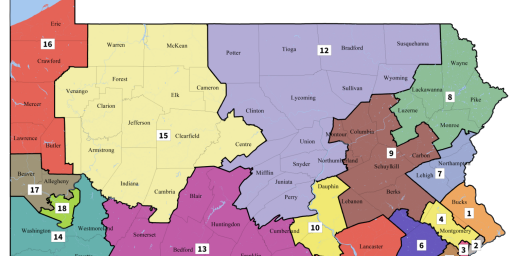
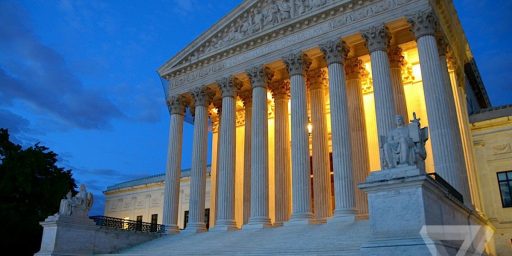

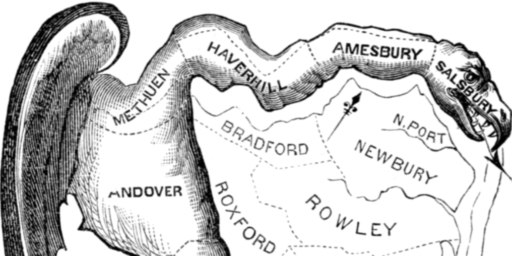
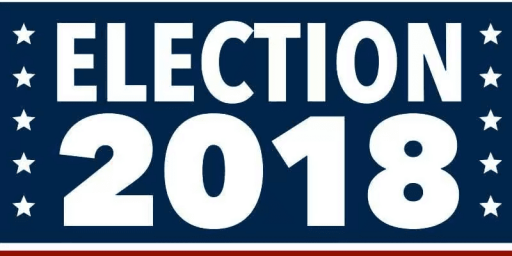
Look at New England. Susan Collins is the last Republican.
Hell…look at Orange County, CA.
Who drew those district maps?
Red Wave!! Whoooo!
I think Christie was also a factor in this. He was a mini-Trump before Trump himself, and he ended up looking like a pathetic clown. Trump is also looking more and more hapless and idiotic by the minute. And while NJites and NYers will tolerate a lot of assholery in exchange for winning(!), they will dump a loser faster than just about anyone.
If you’re a Republican in a blue state, and you want to have a chance of keeping your seat, it’s probably wise to distance yourself from Trump–as far as you can.
Everyone should remember that the Republican tax bill raised taxes for a large portion of the New Jersey middle class. That was very unpopular here.
If the Repubs get trashed again in 2020 (that’s not a prediction) I think we will start to see a mirror image of the 80’s and 90’s. Instead of racist Southern Democratic Pols realizing the world had moved on and if they wanted to go on keeping the darkies down they would need to suddenly find they were Republicans at heart because of “fiscal conservatism”. I think we may find many Northern Republican Pols suddenly finding themselves shocked to discover racism in their own party and regretfully becoming Dems.
So…definitely not voter suppression?
Am I the only person bothered by the phrase “entirely decimated”? =)
@Ron:
Lousy commoners don’t appreciate the benefit of giving money to the rich.
Who could have possibly seen that coming?
@Stormy Dragon: … entirely decimated, ten times. Fixed that for you. Sort of.
Given that substantially more than 8% of the voters in NJ voted for Republicans, it’s a shame that they have so little representation in the House from that state.
Is this the result of someone trying to create districts so there were more than leaned Republican, only to watch them all tip over in a blue wave? Or did she mething else happen?
We really should have a better system that more closely reflects the will of the voters, and which leaves the Republicans in Hoboken feeling like they have someone representing their interests in Washington. But, this would have to be a national thing.
Until then: so sad.
@Resistance Ron:
While you are only half serious, and mostly just trying to score points on some imaginary scoreboard, this is an actual problem.
Here’s some background: https://en.m.wikipedia.org/wiki/New_Jersey_Redistricting_Commission
So, a bipartisan redistricting committee, with a Republican tie-breaker vote, rejiggered things to try to get an extra Republican Representative. They may have spread their base too thin for a blue wave. So sad.
In a more just allocation of Representatives, NJ would be a lot closer to 40+% Republicans representing them than 8.3%. But, in that world with more just allocation of Representatives, Texas would look a lot more purple too.
And, it would be better for people in both states.
@Gustopher: It’s rigged!
@Gustopher:
It’s a bit strange that an independent commission would have chosen these lines, as several districts (NJ-3, 4 and 12) have portions in both the Philadelphia and the New York media markets, greatly increasing the candidates’ advertising costs. I guess with a Republican lean to the Commission, they felt that Republicans would have more money to spend, giving the R’s a small advantage.
@CSK:
By changing parties.
@Resistance Ron: The same gerrymandering that gave them a 50/50 split in 2014 got them all but wiped out in 2018. I just can’t imagine what could have made all those Republican lean voters to suddenly vote DEM. Now what could it be….
@OzarkHillbilly: NJ ranks #10 on the list of Most Educated States.
Support for Trump is negatively correlated with education.
Trump won 8 out of the 10 least-educated states.
@Gustopher:
As our esteemed Professor Taylor would tell you, this is the normal outcome of First Past the Post elections, and can easily occur whether gerrymandering exists or not. If Republicans are so unpopular that their percentage of the electorate in some hypothetical perfectly divided electoral map has districts that range from say, 10% to 49% of the vote then (assuming only two candidates in each) they lose every seat. And their previous attempts to gerrymander this makes it worse.
We often throw around the term gerrymandering but let’s look at how it really works. Again, taking a hypothetical perfectly divided map, let’s say there are 10 districts. 2 of them go Dem by an 80/20 vote, 2 go Repub by the same margin, and the remaining six are toss ups. Then the Repubs gerrymander by taking some solid Democratic sub-areas from the toss up districts and putting them in those two solid red districts and moving the corresponding solid Republican sub-areas into the toss up districts. So all six of those toss up areas are turned into lean-Republican districts (and the original 2 become also have a significantly smaller Republican lean). So with a 50/50 distribution of the vote, you get 8 Repub seats and 2 Dems.
But what happens when the Repubs suffer a general fall from favor? When those two original 80/20 Red districts become, say, 60/40 in distribution? Well, now the Repubs are in real trouble. The Dems keep the districts that were made to be overwhelming Republican, but all the districts that became 55/45 Repub, including the original strong Republican districts, are lost. They end up with no seats at all. That’s essentially what happened in NJ
Atrios has a post including a a tweet of a similar, but worse for Republicans, map of Orange County, along with some well deserved snark directed at Bret Stevens. There are six districts in the County. In 2016 four were red and two blue. 2018 is six blue. How long has Orange County been the exemplar of permanent deep red suburbs?
The GOPs have chosen to exacerbate an urban rural divide as the only way they can get elected, and chose the rural side. Now, maybe, it’s biting them in the ….derriere. (The rural population is 19%.)
Remember after redistricting the boundaries of the district are fixed, but the voters aren’t. Some die, some move out, some move in. We just had the next to last election using districts configured from the 2010 census, it stands to reason that the population mix has changed and then you add in the factor of the effect of the Repug tax cuts and Trump…
I suspect that the fact that the tax bill capped the home mortgage deduction played a role both in New Jersey and in Orange County. Especially since the R Reps voted for it. I can well imagine a lot of those voters asking, “if they can’t keep my taxes down, what are they good for?”
@gVOR08:
Orange County has had a big influx of Indian and Pakistani families. They’ve noticed that there is a party for white people, and a second party for everyone of any color. It’s kind of wonderful the way the GOP has set about ensuring their own destruction by alienating the two fastest-growing immigrant groups – groups that in the absence of Republican racism would be likely to be conservative. There’s no reason why Indians, Chinese, southeast Asians, Muslims and Hispanics should be lined up with liberals – no reason but Republican racism.
@Resistance Ron: I recommend a brief course in map reading before you go off-road, my friend.
You saw those three maps of NJ, yes? The different results are the result of voters making different choices. For ‘gerrymandering’ to have been the cause of all that blue, there would have to have been – uh, gerrymandering? Meaning the boundaries would be changed. You got that, right?
I think you meant Democratic here. But yeah, trolls should read your explanation. Republicans performed gerrymandering that would have given them an advantage in a 50/50 race, but turned sharply against them when Dems were up broadly. If Republicans had drawn fair lines they wouldn’t have shot themselves in the foot so badly.
Fuckin Math: how does it work?
@Resistance Ron: Gerrymandering didn’t cause New Jersey’s blue wave. When the districts were last redrawn in 2011, the state had a Republican governor who had to sign off on the redrawn district lines put forth by the Democratic legislature.